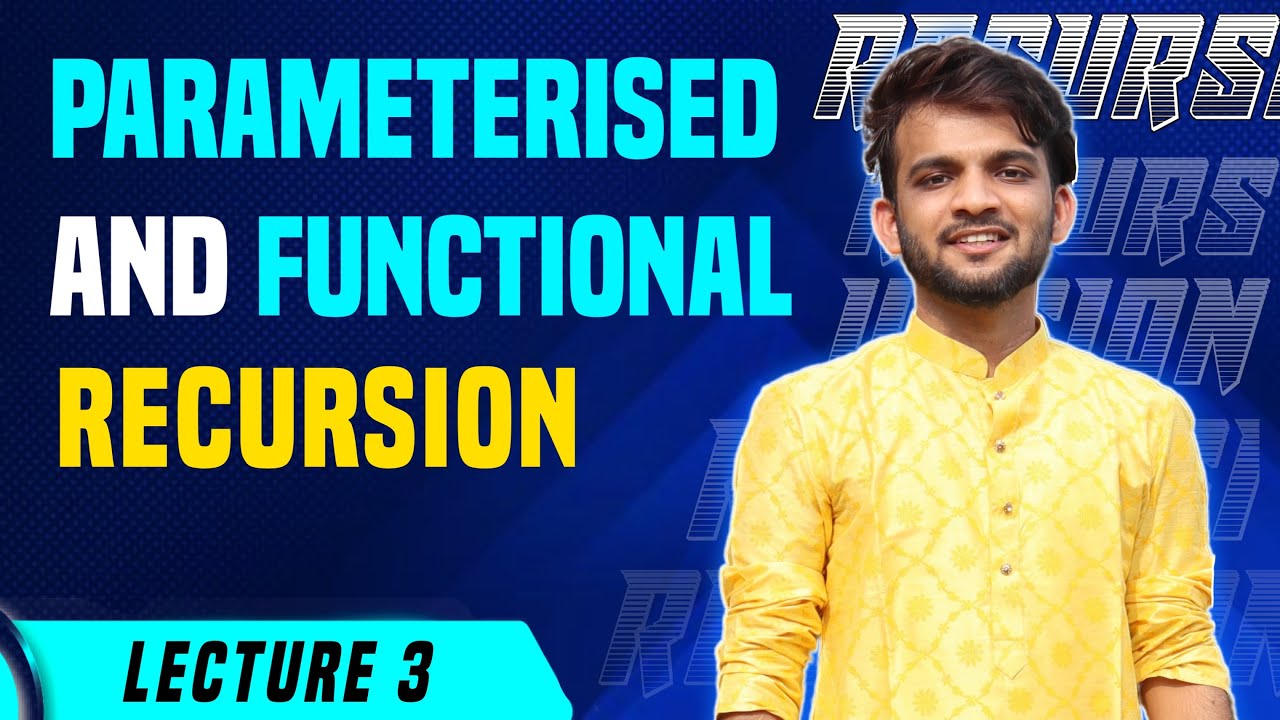Re 2. Problems on Recursion | Strivers A2Z DSA Course
Summary
TLDRThis video, sponsored by Code Studio, offers a comprehensive guide to basic recursion problems, ideal for interview preparation. The presenter introduces over 2000 coding problems, solutions in C, Java, and Python, and guided paths for various topics. The tutorial focuses on recursive functions to print a name or numbers in a sequence, both linearly and in reverse, using parameters effectively without global variables. The explanation includes the concept of backtracking and emphasizes understanding recursion flow and complexity, ensuring viewers grasp the foundational concepts of recursion.
Takeaways
- 😀 The video is sponsored by Code Studio, a platform with over 2000 interview problems and solutions in C, Java, and Python.
- 📚 Code Studio offers guided paths for various subjects like Python, DBMS, OOP, OS, computer networks, system design, and web development.
- 🏢 It also provides top company interview questions, such as Amazon's coding questions, and a collection of interview experiences from companies like Amazon, Microsoft, Adobe, and Google.
- 🔗 There are free resources available for interview preparation on Code Studio, with a link provided in the video description.
- 📈 The video focuses on basic recursion problems, building on a previous lecture about recursion.
- 🔑 The first problem discussed is printing a name 'n' times using recursion, emphasizing the importance of base cases and recursive calls.
- 🔄 The concept of changing parameters in recursion is introduced, with an example of printing a name 'n' times without using global variables.
- 🕵️♂️ The video explains how recursion works with a step-by-step breakdown of function calls and returns, using the example of printing a name.
- 📉 The time and space complexity of the recursion examples are discussed, highlighting that both are O(n) for the given problems.
- 🔢 Additional recursion problems, such as printing numbers linearly from 1 to n and vice versa, are covered with a focus on understanding the logic behind the recursive calls.
- 🔄 Backtracking is introduced as a recursion technique, demonstrated by printing numbers in increasing order but with the print statement placed after the recursive call.
- 💡 The video challenges viewers to think about recursion in reverse order and to solve problems by starting from the end, encouraging active learning and participation.
Q & A
What is the main topic of the video?
-The main topic of the video is solving basic recursion problems in programming.
Who is the sponsor of the video?
-The sponsor of the video is Code Studio, a platform for practicing interview problems.
What kind of problems does Code Studio offer solutions for?
-Code Studio offers solutions for over 2000 problems in various topics including C, Java, Python, DBMS, OOP, OS, computer networks, system design, web development, and more.
How can viewers find top company interview questions on Code Studio?
-Viewers can find top company interview questions via tags, such as 'Amazon', and get all the top coding questions along with their solutions in C, Java, and Python.
What additional resource does Code Studio provide for interview preparation?
-Code Studio provides over 600 interview experiences from companies like Amazon, Microsoft, Adobe, and Google.
What is the first recursion problem discussed in the video?
-The first recursion problem discussed is to print a name 'n' times using recursion.
What is the base case for the 'print name n times' recursion problem?
-The base case for the 'print name n times' problem is when 'i' exceeds 'n', at which point the function returns and stops the recursion.
How does the video explain the concept of changing parameters in recursion?
-The video explains changing parameters by demonstrating how to modify the function call to 'f(i + 1, n)' after printing the name, to continue the recursion until the base case is met.
What is the time complexity of the 'print name n times' recursion problem?
-The time complexity of the 'print name n times' recursion problem is O(n), as the function is called 'n' times.
What is the space complexity of the 'print name n times' recursion problem?
-The space complexity of the 'print name n times' recursion problem is also O(n), due to the stack space used by each recursive call waiting to be completed.
How does the video introduce the concept of backtracking in recursion?
-The video introduces backtracking by not allowing the use of 'i + 1' and instead using 'i - 1' to print numbers from 'n' to '1', demonstrating how the print statement can be executed after the recursive call.
What is the challenge posed by the video for the viewers at the end?
-The challenge posed by the video is to print numbers from 'n' to '1' using recursion without using 'i - 1, n' as the recursive call, and to share the solution in the comment section.
Outlines

Esta sección está disponible solo para usuarios con suscripción. Por favor, mejora tu plan para acceder a esta parte.
Mejorar ahoraMindmap

Esta sección está disponible solo para usuarios con suscripción. Por favor, mejora tu plan para acceder a esta parte.
Mejorar ahoraKeywords

Esta sección está disponible solo para usuarios con suscripción. Por favor, mejora tu plan para acceder a esta parte.
Mejorar ahoraHighlights

Esta sección está disponible solo para usuarios con suscripción. Por favor, mejora tu plan para acceder a esta parte.
Mejorar ahoraTranscripts

Esta sección está disponible solo para usuarios con suscripción. Por favor, mejora tu plan para acceder a esta parte.
Mejorar ahoraVer Más Videos Relacionados

Re 3. Parameterised and Functional Recursion | Strivers A2Z DSA Course

Coding Interview Questions And Answers | Programming Interview Questions And Answers | Simplilearn

Master VS Code's keyboard shortcuts in 13 minutes

Belajar Python [Dasar] - 02a - Installasi Python dan VS Code di Windows

Stoichiometry - clear & simple (with practice problems) - Chemistry Playlist

F1 Visa Interview Preparation Tips • Plan Visit • What to Wear
5.0 / 5 (0 votes)
